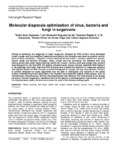Use este identificador para citar ou linkar para este item:
http://www.alice.cnptia.embrapa.br/alice/handle/doc/963146Registro completo de metadados
| Campo DC | Valor | Idioma |
|---|---|---|
| dc.contributor.author | SAWAZAKI, H. E. | pt_BR |
| dc.contributor.author | SA, L. A. N. de | pt_BR |
| dc.contributor.author | GONÇALVES, C. R. N. C. B. | pt_BR |
| dc.contributor.author | VEIGA, R. F. A. | pt_BR |
| dc.contributor.author | COLOMBO, C. A. | pt_BR |
| dc.date.accessioned | 2013-08-01T11:11:11Z | pt_BR |
| dc.date.available | 2013-08-01T11:11:11Z | pt_BR |
| dc.date.created | 2013-08-01 | pt_BR |
| dc.date.issued | 2013 | pt_BR |
| dc.identifier.citation | Internacional Research Journal of Plant Science, Sapele, v. 4, n. 3, p. 76-83, 2013. | pt_BR |
| dc.identifier.uri | http://www.alice.cnptia.embrapa.br/alice/handle/doc/963146 | pt_BR |
| dc.description | Abstract: Aiming at optimizing the diagnosis of major sugarcane diseases by PCR, primers were developed (scald, orange rust) and amplified fragments according to the literature were used as positive control, such as those caused by: 1 - Bacteria, (ratoon stunting and leaf scald) 2 - Viruses, (yellow leaf, mosaic, mosaic streak and fijivirus) 3-Fungus, (smut, orange rust and curvularia). For diseases with long latency period (leaf scald, ratoon stunting, yellow leaf, mosaic, fijivirus, smut and orange rust), primers were designed for real time PCR. For testing, infected leaves, fungal colonies, amplified DNA fragment or 40 seedlings were used. Real time PCR analyses have enabled the detection of sugarcane samples with highest dilution of DNA. The pair of primers designed for orange rust was more specific. The pair of primers designed for scald, apparently was not able to distinguish only bacteria of the genus Erwinia, whereas the primers described in the literature were observed amplify others genera, such as Xanthomonas, Pseudomonas, Erwinia, Stenotrophomona and Pantoea. The three strains of the fungus curvularia, found in sugarcane, resembled more to the species C.cymbopogonis, C.geniculata, C.sp. Of the 28 primer pairs tested, the best were shown for each of the disease-causing agent. | pt_BR |
| dc.language.iso | eng | eng |
| dc.rights | openAccess | eng |
| dc.subject | Leaf scald | pt_BR |
| dc.subject | PCR | pt_BR |
| dc.title | Molecular diagnosis optimization of virus, bacteria and fungi in sugarcane. | pt_BR |
| dc.type | Artigo de periódico | pt_BR |
| dc.date.updated | 2013-08-02T11:11:11Z | pt_BR |
| dc.subject.thesagro | Cana de açúcar | pt_BR |
| dc.subject.thesagro | Doença de planta | pt_BR |
| dc.subject.thesagro | Diagnóstico | pt_BR |
| dc.subject.thesagro | Bactéria | pt_BR |
| dc.subject.thesagro | Vírus | pt_BR |
| dc.subject.thesagro | Fungo | pt_BR |
| dc.subject.thesagro | Escaldadura | pt_BR |
| dc.subject.thesagro | Ferrugem alaranjada | pt_BR |
| dc.subject.nalthesaurus | Plant diseases and disorders | pt_BR |
| dc.subject.nalthesaurus | Sugarcane | pt_BR |
| dc.subject.nalthesaurus | Ratoon stunting disease | pt_BR |
| dc.subject.nalthesaurus | Scald diseases | pt_BR |
| dc.subject.nalthesaurus | Sugarcane yellow leaf virus | pt_BR |
| dc.subject.nalthesaurus | Sugarcane streak virus | pt_BR |
| dc.subject.nalthesaurus | Fijivirus | pt_BR |
| dc.subject.nalthesaurus | Smut diseases | pt_BR |
| dc.subject.nalthesaurus | Rust diseases | pt_BR |
| dc.subject.nalthesaurus | Curvularia | pt_BR |
| dc.subject.nalthesaurus | Polymerase chain reaction | pt_BR |
| riaa.ainfo.id | 963146 | pt_BR |
| riaa.ainfo.lastupdate | 2013-08-02 | pt_BR |
| dc.contributor.institution | HAIKO ENOK SAWAZAKI, IAC; LUIZ ALEXANDRE NOGUEIRA DE SA, CNPMA; CASSIARA REGINA NOVENTA CORREA BARBOSA GONÇALVES, CTC; RENATO FERRAS DE ARRUDA VEIGA, IAC; CARLOS AUGUSTO COLOMBO, IAC. | pt_BR |
| Aparece nas coleções: | Artigo em periódico indexado (CNPMA)  | |
Arquivos associados a este item:
| Arquivo | Descrição | Tamanho | Formato | |
|---|---|---|---|---|
| 2013AP16.pdf | 826.05 kB | Adobe PDF |  Visualizar/Abrir |









